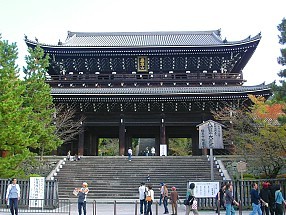Anyone who travels to Kyoto or reads up on the city will quickly learn 1) that Kyoto is the historical capital of Japan, a title it held for more than a millenia until the Meiji Restoration in 1868, and 2) that although it is no longer the political capital, it is still widely considered the cultural capital of Japan. Kyoto is where most of Japan's few modern-day geisha live; it is the home to literally thousands of temples that are profoundly symbolic to Japanese history and modern identity; it is a place where traditional Japanese arts such as the tea ceremony still flourish.
Most visitors arrive with that basic knowledge and dutifully set out day after day, map in hand, to put as big a dent as their schedule permits into a long list of temples to see. And, even though I could remember the feeling of temple-fatigue from my visit 10 years earlier, I couldn't resist my duty to temple hop, map in hand, husband in step. Having divided our time with non-temple activities (which was the best decision we made), we got to (only?) a handful of temples, boldly crossing them off of our list.
It is hard to describe what makes each temple unique, even 5 months after the fact, so I'll be brief and, for the sake of those who might read this and visit subsequently, I will list them in order of "so worth it" to "not worth it. seriously, not worth it" -- hope it might be helpful to someone, somewhere.
Chionin Temple
My attempt to capture the massive entry gate to this temple, were a complete failure, In order to not distract from the fact that a visit to Chionin is so worth a visit, I pulled a photo from the internet that does it justice. Thanks, internet!
Courtesy of japan-guide.com, a must-review resource for anyone who visits Japan.
I enjoyed Chionin Temple primarily because the temple grounds are much more expansive than at many other places (a la Kinkaku-ji, Ginkaku-ji). We were able to enjoy just walking around and feeling like we were exploring rather than feeling like a sheep being shepherded down a single garden pathway, unable to stop for fear of holding up the line (think: a visit to the Mona Lisa). The grounds of Chionin boast several buildings, lots of stairs, and a graveyard that extends farther back into the abutting hillside than we were willing to explore. All-in-all a really pleasant and considerably less crowded temple experience than average.
Location: West/Philosopher's Path
Kinkaku-ji
Kyoto's Golden Pavilion is, despite the husbo's disagreement, a must visit site. While visitors cannot enter the pavilion itself, you can take a walk around the grounds, pass through the (former) living quarters of the head priest and, if you like, take a cup of tea in the tea garden.It is worth mentioning that it is a bit out of the way. We visited Kinkaku-ji after Arashiyima (see previous blog post) taking the train in a way from Arashiyama, and then taking a cab.
Location: North
Kiyomizudera Temple
We went to this independent Buddhist temple in the wooded hillside at Kyoto's eastern most edge on the recommendation of Vince's co-worker, and when in Japan, I have learned to always take recommendations from the Japanese because they will only recommend the best. This beautiful temple is literally perched on a hillside, as in fully supported by stilts on one side, making it feel something like an epic, yet pristine tree house. The grounds feature many other beautiful structures and nice views of Kyoto (it was quite overcast and a bit drizzly, so I have no worthy photos to post) and, though it is a healthy distance from the city center, it is so worth it.If my review and picture don't have you convinced, bear in mind that the majority of the buildings were under construction during our visit (the pagoda which I hid in the background was completely wrapped up on our visit - May 2014). The construction is scheduled to continue for the next several years, and yes that is something of a drawback, and no it doesn't change my opinion.
Location: West
Yasaka Shrine
We ended up by Yasaka Shrine by pure accident. On day, we decided to wrap up our full day of sightseeing in Gion, a historic neighborhood of Kyoto filled with shops and bars. After stopping for a few laps of fire-water at a whiskey bar and in search of dinner, we reached the far western edge of Gion, which runs directly into the entrance of yet another of the thousands of religious sites (shrines and temples) that dot the city. And, in a show of continued dedication to the Kyoto experience, we couldn't say no. By night, the grounds were quite impressive, if a liiiittle bit scary.
Yasaka Shrine is apparently the site of some big festivals in the summer, but where we were there it was virtually devoid of people. While I wouldn't go out of my way to see it during the day, it is a great site to stop by after sunset. It seemed that most of Kyoto's religious sites close around 4 or 5pm, so there are not many places you can photograph at night. A visit to Yasaka diversifies the Kyoto experience, and diversity is the spice of life now isn't it?
Location: West/Gion
Ginkaku-ji


Well, there it is, in all of its underwhelming splendor. The temple's name, Ginkaku-ji, means Silver Pavillion and unintentionally but appropriately suggests that it comes in a (distant) second to the Gold Pavillion that was the inspiration for Ginkaku-ji's construction. The grounds are small and include only a very short walk, chock full of people dutifully "awe"ing in a single file, through a tiny rear yard. With everything there is to see in Kyoto, skip this.
Location: West/Philosopher's Path







No comments:
Post a Comment